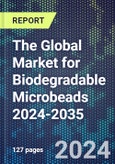The market for biobased microbeads represents a rapidly evolving segment within the broader sustainable materials industry, driven by increasing environmental regulations and consumer demand for eco-friendly alternatives to conventional plastic microbeads. These microscopic spherical particles, typically ranging from 1 to 1000 micrometers in diameter, are derived from renewable biological sources such as plant cellulose, algae, agricultural waste, and biodegradable polymers. The global biobased microbeads market has experienced significant growth following regulatory restrictions on synthetic plastic microbeads in personal care products.
Countries including the United States, Canada, the United Kingdom, and several EU nations have implemented bans on plastic microbeads in rinse-off cosmetics due to their environmental persistence and potential harm to marine ecosystems. This regulatory landscape has created substantial opportunities for biobased alternatives that offer similar functional properties while maintaining biodegradability.
The biobased microbeads market encompasses a diverse range of natural materials and biodegradable polymers, each offering unique performance characteristics and application potential. From polysaccharides like starch, cellulose, and chitin to proteins including collagen and casein, the material landscape continues to expand with innovations in polyesters such as polyhydroxyalkanoates (PHA) and polylactic acid (PLA). Additionally, emerging materials like lignin and alginate present new opportunities for specialized applications across industries.
Key applications for biobased microbeads span multiple industries, with personal care and cosmetics representing the largest market segment. These products serve as gentle exfoliants in facial scrubs, body washes, and toothpaste, providing the tactile and aesthetic properties consumers expect while addressing environmental concerns. Beyond personal care, biobased microbeads find applications in pharmaceuticals as drug delivery systems, in agriculture as controlled-release fertilizer carriers, and in industrial processes as biodegradable abrasives.
The competitive landscape features a mix of established chemical companies and innovative startups developing novel biobased solutions. Major players include companies producing cellulose-based microbeads from wood pulp and cotton, while emerging technologies focus on algae-derived particles and agricultural waste conversion. Manufacturing processes typically involve controlled precipitation, spray drying, or specialized polymerization techniques to achieve desired particle size distributions and functional properties.
Market growth drivers include strengthening environmental regulations, corporate sustainability commitments, and growing consumer awareness of microplastic pollution. The beauty and personal care industry's shift toward "clean" formulations has particularly accelerated adoption. Additionally, technological advances have improved the performance characteristics of biobased microbeads, addressing early concerns about effectiveness and shelf stability.
However, the market faces several challenges. Production costs for biobased alternatives typically exceed those of conventional plastic microbeads, though this gap is narrowing with scale and technological improvements. Supply chain development remains a consideration, as consistent quality and reliable sourcing of raw materials require ongoing investment. Additionally, biodegradation rates and environmental fate studies continue to be areas of active research and regulatory scrutiny.
Regional market dynamics vary significantly, with Europe leading in both regulatory pressure and market adoption, followed by North America. Asia-Pacific markets show growing interest, particularly in countries implementing stricter environmental standards. The market structure includes both direct replacement of existing plastic microbeads and development of new applications leveraging unique properties of biobased alternatives. The market prospects appear robust, supported by expanding regulatory frameworks, increasing corporate environmental commitments, and continued innovation in raw materials and processing technologies. Industry analysts project sustained double-digit growth rates through the next decade, with market expansion driven by both regulatory compliance and voluntary adoption of sustainable alternatives across diverse applications.
The Global Market for Biobased Microbeads: Market Report 2026-2036 provides critical insights into the rapidly evolving landscape of biobased microbeads from 2026 to 2036, analyzing market drivers, technological innovations, application segments, and competitive dynamics across multiple industries. Market segmentation analysis reveals significant opportunities across multiple application areas, with personal care and cosmetics leading adoption rates due to regulatory pressure and consumer demand.
The agricultural and horticultural sectors present substantial growth potential for controlled-release applications, while paints and coatings, soap and detergents, oil and gas, and medical products offer diverse market entry points. Emerging applications in 3D printing, textiles, and food packaging represent future growth vectors for innovative market participants.
Manufacturing technologies and processes continue to evolve, with advances in melt processing, extrusion techniques, solvent-based production methods, and emulsion and spray-drying technologies enabling improved quality control and particle size distribution. These technological developments directly impact cost competitiveness and market penetration potential across various application segments.
Report contents include:
- Regulatory Landscape Analysis: Comprehensive examination of microplastics legislation across major markets including REACH compliance, US federal regulations, Canadian restrictions, Australian guidelines, and emerging Asian regulatory frameworks
- Material Technology Assessment: Detailed evaluation of natural hard materials, polysaccharides (starch, cellulose variants, chitin), proteins (collagen, gelatin, casein), polyesters (PHA, PLA), and other natural polymers (lignin, alginate)
- Manufacturing Process Innovation: Analysis of melt processing, extrusion techniques, solvent-based production, emulsion technologies, spray-drying methods, and quality control systems
- Market Penetration Barriers: Identification of technical limitations, cost competitiveness challenges, supply chain constraints, and regulatory compliance requirements
- Application Market Sizing: Quantitative analysis of microplastics volumes across personal care (2024-2036), cosmetics, agriculture and horticulture, paints and coatings, soap and detergents, oil and gas, and medical products
- Regional Market Dynamics: Geographic analysis covering North America, Europe, Asia-Pacific, and emerging markets with volume projections in metric tons
- Competitive Intelligence: Comprehensive profiles of 40 leading companies developing biobased microbead technologies and commercial solutions. Companies profiled include
- Environmental Impact Assessment: Analysis of marine pollution mitigation, toxicological effects reduction, and human health implications
- Price Elasticity and Cost Analysis: Economic modeling of market adoption rates, price sensitivity, and cost-competitiveness factors
- Technology Readiness Assessment: Evaluation of commercialization timelines, market readiness levels, and adoption barriers across different application segments
- SWOT Analysis Framework: Systematic assessment of market strengths, weaknesses, opportunities, and threats affecting industry development
- Emerging Applications: Forward-looking analysis of 3D printing, textile applications, and food packaging opportunities
This product will be delivered within 1-3 business days.








